
A wargame is a strategy game in which two or more players command opposing armed forces in a simulation of an armed conflict. Wargaming may be played for recreation, to train military officers in the art of strategic thinking, or to study the nature of potential conflicts. Many wargames re-create specific historic battles, and can cover either whole wars, or any campaigns, battles, or lower-level engagements within them. Many simulate land combat, but there are wargames for naval, air combat, and cyber as well as many that combine various domains.

Panzer General is a 1994 computer wargame developed and published by Strategic Simulations Inc. (SSI). It simulates conflict during World War II. The designers of Panzer General were heavily influenced by the Japanese wargame series Daisenryaku.

Carentan is a small rural town near the north-eastern base of the French Cotentin Peninsula in Normandy in north-western France, with a population of about 6,000. It is a former commune in the Manche department. On 1 January 2016, it was merged into the new commune of Carentan-les-Marais. The town was a strategic early goal of the World War II landings as capturing the town was necessary to link the lodgements at Utah and Omaha beaches which were divided by the Douve river estuary. The town was also needed as an intermediate staging position for the capture of the cities of Cherbourg and Octeville, with the critically important port facilities in Cherbourg.
Battle Cry is a board wargame based on the American Civil War, designed by Richard Borg and published by Avalon Hill in 2000.

Eastern Front (1941) is a computer wargame for Atari 8-bit computers created by Chris Crawford and published through the Atari Program Exchange (APX) in 1981. A scenario editor and assembly language source code for the game were also sold by APX as separate products.

Battle of the Bulge is a board wargame published by Avalon Hill (AH) in 1965 that simulates the World War II battle of the same name. General Anthony McAuliffe (ret.), who had been commanding officer at Bastogne during the Battle of the Bulge, was a consultant during the game's development. The game proved popular and sold more than 120,000 copies, but was dogged by criticisms of historical inaccuracies, and was finally replaced by a completely new edition in 1981. A third edition in 1991 was released as part of the Smithsonian American History Series.
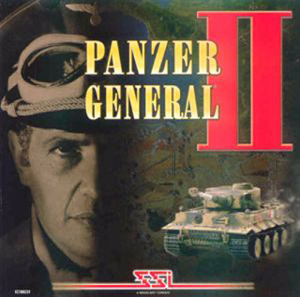
Panzer General II is a computer wargame by Strategic Simulations, Inc. Released October 15, 1997, Panzer General II is the sixth SSI game in the Panzer General series and the first in the "Living Battlefield" series. It takes place during World War II, covering events from the Spanish Civil War in 1938 to hypothetical battles in 1946. In the April 2000 issue of the magazine PC Gamer, it was voted the 44th best computer game of all time, and the highest rating in the Panzer General series. The game was re-released in 2010 on GOG.com.

Battleground 2: Gettysburg is a 1995 turn-based computer wargame developed and published by TalonSoft. It the second game in the Battleground series.

Battleground 4: Shiloh is a turn-based computer wargame developed by TalonSoft in 1996 and the fourth issue in the Battleground series.

Empire is a 1977 turn-based wargame with simple rules. The game was conceived by Walter Bright starting in 1971, based on various war films and board games, notably Battle of Britain and Risk. The game was ported to many platforms in the 1970s and 1980s. Several commercial versions were also released, often adding basic graphics to the originally text-based user interface. The basic gameplay is strongly reminiscent of several later games, notably Civilization, which was partly inspired by Empire.

Close Combat: A Bridge Too Far, or Close Combat II, is a World War II real-time computer wargame, developed by Atomic Games, and released on October 13, 1997. The second installment of the Close Combat series, the game is played on a two-dimensional map, between two players.
V for Victory, or V4V for short, is a series of turn-based strategy games set during World War II. They were the first releases for Atomic Games who went on to have a long career in the wargame industry.
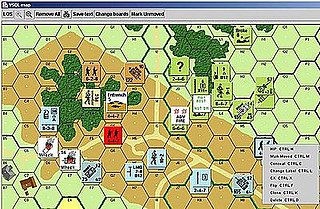
A computer wargame is a wargame played on a digital device. Descended from board wargaming, it simulates military conflict at the tactical, operational or strategic level. Computer wargames are both sold commercially for recreational use and, in some cases, used for military purposes.
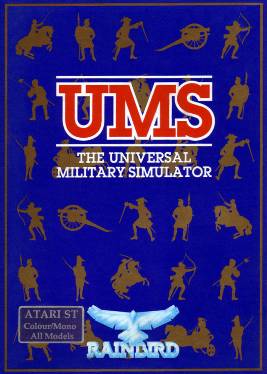
The Universal Military Simulator is a computer game developed by Rainbird Software in 1987 for the Macintosh, Tandy 4000, and IBM PC compatibles. In 1988, both Atari ST, Amiga versions were released. The game was created by Ezra Sidran. The PC and Amiga versions were ported by Ed Isenberg. The game spawned two sequels: UMS II: Nations at War and The War College: Universal Military Simulator 3.

Harpoon is a computer wargame published by Three-Sixty Pacific in 1989 for DOS. This was the first game in the Harpoon series. It was ported to the Amiga and Macintosh.
Panzer Campaigns is a series of operational level wargames originally developed by John Tiller Software, and currently by Wargame Design Studio. The games were originally published until 2010 by HPS Simulations, then self published by John Tiller Software until being bought out by Wargame Design Studio in 2021, after Tiller's death. There are currently 29 titles in the series, spanning the various fronts of World War II.
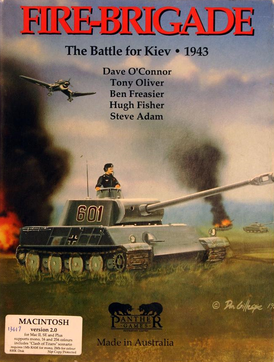
Fire-Brigade: The Battle for Kiev - 1943 is a computer wargame developed and published by Panther Games in Australia in 1988. The game is set around the historical WWII Eastern Front Battle of Kiev in 1943.

V for Victory: Velikiye Luki is 1992 computer wargame developed by Atomic Games and published by Three-Sixty Pacific. It is part of the V for Victory series.
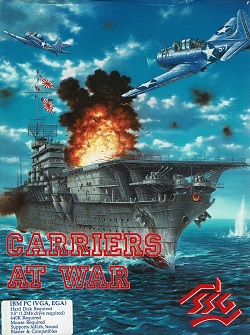
Carriers at War 1941-1945: Fleet Carrier Operations in the Pacific is a 1992 wargame by Strategic Studies Group for MS-DOS and Macintosh. It is a remake of the 1984 Carriers at War. An expansion pack, Carriers at War: Construction Kit, was released in 1993. A sequel, Carriers at War II, was also released in 1993.

Atlantic Wall, subtitled "The Invasion of Europe June 1944", is a board wargame published by Simulations Publications Inc. (SPI) in 1978 that simulates Operation Overlord during World War II, when Allied forces landed on Normandy beaches and attempted to break out into open country.

















